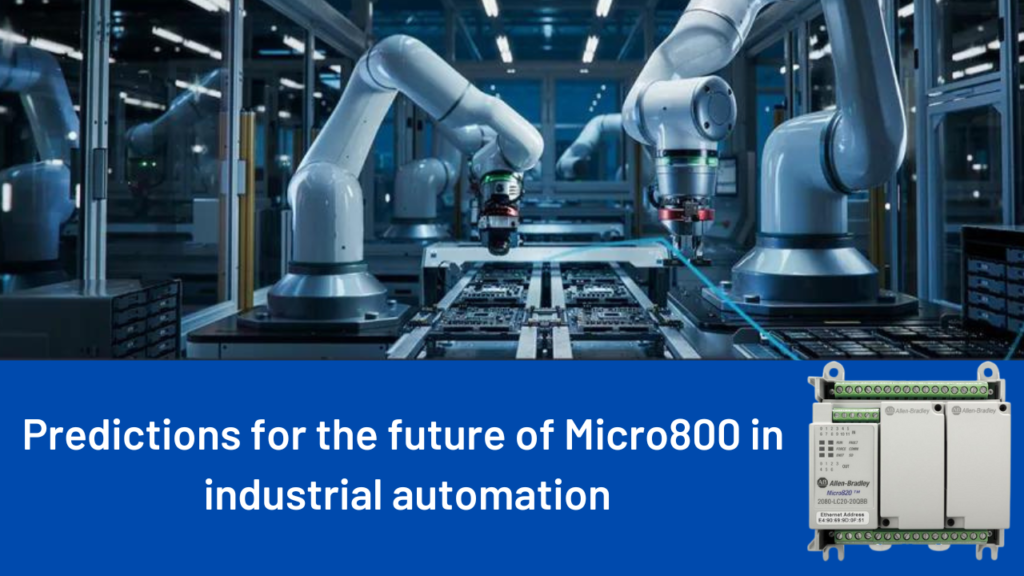The Micro800 series, which encourages adaptability and efficiency in production processes, has emerged as a major player in the dynamic field of industrial automation. In the future, a number of advancements and patterns suggest that the Micro800 series will remain crucial in defining the course of industrial automation.
Increased Integration with Industry 4.0 Technologies:
As the industry continues to move toward Industry 4.0 and the Industrial Internet of Things (IIoT), Rockwell Automation Micro800 PLCs may see improved integration capabilities with edge computing devices, cloud platforms, and smart sensors. This combination would enable improved connection and more data-driven decision-making.
It may be possible to quickly integrate Micro800 PLCs with sensors and Internet of things devices. PLCs may need to implement protocols like MQTT (Message Queuing Telemetry Transport) or CoAP (Constrained Application Protocol) in order to enable efficient communication with IoT-enabled devices.
Micro800 PLCs equipped with edge computing capabilities to process data nearer to the source and with reduced latency. This facilitates local data analysis and decision-making for real-time applications and responsiveness.
Enhanced Communication Protocols:
In order to guarantee compatibility with the most recent industrial networking technologies, updates that support updated communication protocols can required. This might entail advancements in Ethernet-based communication protocols, fieldbus system integration, and wireless technologies.
In the future, Micro800 PLCs could have better support for wireless communication technologies like Bluetooth and Wi-Fi. This can enable the deployment of wireless sensors and devices and increase the flexibility of system design.
Improved Programming and Configuration Tools:
The programming and setup tools for the Micro800 PLC might be improved. This might involve more complex programming languages, more user-friendly interfaces, and improved debugging and diagnostics tools to expedite the development process.
It would be reasonable to expect the introduction of more advanced programming languages or enhancements to those that already exist. By supporting high-level languages, structured text, or function block diagrams, this might provide users greater flexibility in expressing their control logic.
It can be simpler for developers to identify and address issues with the use of improved debugging and simulation tools. Future tools might allow programmers to verify their logic before placing it on the Micro800 PLC itself by offering real-time simulation. Breakpoints and variable tracking are two more sophisticated capabilities that can help with debugging.
Cybersecurity Features:
With the increasing focus on industrial cybersecurity, future Allen Bradley Micro800 PLC versions may include enhanced security features to prevent hacks. Examples of this might include advanced encryption, secure communication protocols, and authentication methods.
Ensuring the integrity and authenticity of linked devices is necessary to prevent tampering and unlawful access. Future Micro800 PLCs may include integrity checks and device authentication techniques to verify the legitimacy of connected devices.
Scalability and Flexibility:
The Micro800 series may get even more scalable as automation requirements rise, allowing for easy expansion.
Support for extra I/O points, greater memory, and seamless connectivity with other Rockwell Automation products are some potential characteristics of this scalability.
Better memory and storage capacity might free up more resources for users to store and execute control logic. This is particularly important when automation systems become more sophisticated and resource-intensive.
Micro800 PLC systems with more modular designs allow users to easily extend or change their systems by adding or changing modules without having to restart the entire system.
Future Micro800 PLCs could have better communication interfaces that support a number of protocols and standards. This adaptability ensures compatibility with a broad range of field devices, sensors, and industrial equipment.
Energy Efficiency and Sustainability:
Future Micro800 PLCs could be equipped with features that improve industrial processes’ use of energy, in line with global trends toward sustainability. This could need combining energy monitoring tools and algorithms to increase overall system efficiency.
In the future, Micro800 PLCs may have power management functions that would enable users to optimize the energy usage of linked devices and components. This can include putting non-critical components on lower power or planning power-off periods for when manufacturing isn’t going on.
Micro800 PLCs can swiftly adapt to changes in energy pricing or grid conditions when connected with demand response systems.
Customers can save on production schedules and energy use by adjusting these patterns during periods of low demand.
Training and Support:
It is expected that Rockwell Automation will continue to provide Micro800 users with training and support in the form of documentation, software updates, and instructional materials. Users may take advantage of the newest features and functions by doing this.
Training programs that use AR and VR technology may provide users with realistic, immersive experiences. This may entail virtual environments that let people engage with virtual Micro800 PLCs and simulate real-world scenarios.
Official certification programs can be developed for Micro800 PLCs in order to validate users’ skills and knowledge. These programs may provide several certification tiers so that users may progress as their abilities grow.
Webinars and e-learning courses that offer thorough insights into advanced features, best practices, and use cases that are pertinent to a particular application can address Micro800 PLC-related topics in-depth. These materials can updated often to reflect the latest changes.
There is a bright future for the Micro800 series in the quickly developing sector of industrial automation. As industries embrace new technologies and meet consumer demands for more sustainability, efficiency, and connectivity, micro800 controllers should evolve. Because it keeps up with emerging trends, the Micro800 series is well-positioned to play a significant role in the shift to smarter, more agile, and networked industrial automation systems.






testosterone and hgh
References:
Hgh X2 Somatropinne; http://Www.Argfx1.Com,
where to get steroids from
References:
no steroid bodybuilding (https://huckerreportcollegiate.com/author/metaldrug5/)
dianabol cycle results
References:
Valley.md
dosage hgh bodybuilding
References:
hgh cycle for beginners (tayseerconsultants.com)
supplements close to steroids
References:
Legal mass building steroids, http://blueroses.top:8888/charakenyon157,
lean steroid cycle
References:
what are Androgenic effects (vsegda-pomnim.com)
cjc 1295 + ipamorelin how long to see results
References:
cjc-1295 ipamorelin and mk677 stack (case.Edu)
igf 1 lr3 and ipamorelin
References:
cjc-1295 and ipamorelin vs sermorelin
blueskypeptide cjc 1295 ipamorelin reviews
References:
ipamorelin immune system (panoptikon.org)
ipamorelin and libido
References:
acetate/ipamorelin acetate
does ipamorelin desensitive
References:
cjc 1295 ipamorelin And testosterone reddit (http://www.3scomputers.Com)
sermorelin + ipamorelin program
References:
ipamorelin theanine combination; https://quenly.com/,